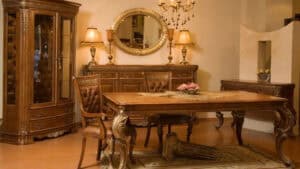
Key Differences of Modern and Contemporary Furniture Design: Modern furniture design is linked to a specific 20th century artistic movement with a strict set of style principles, while the contemporary label has a fluid definition, drawing eclectically from various eras and evolving with current trends and technologies.
Key Takeaways:
- Design principles: Modern furniture adheres to specific minimalist and functionalist design principles like clean lines, simple forms, and lack of ornamentation. Contemporary incorporates varied influences and changes over time.
- Materials: Both tend to use natural materials like wood, leather, and linen, but contemporary also embraces more modern materials like recycled, sustainable options.
- Colors: Modern favors muted, neutral, earthy palettes while contemporary uses bolder, contrasting color schemes.
- Shapes: Modern has straighter lines and edges while contemporary incorporates more curves and rounded edges.
- Comfort: Contemporary furniture tends to prioritize comfort over pure functionality compared to the modern style.
Defining Modern and Contemporary Furniture
Quick Guide:
| Feature | Modern Furniture | Contemporary Furniture |
|---|---|---|
| Time Period | Mid-20th century | Current, evolving |
| Aesthetic | Minimalist, clean lines, functional | Varied, innovative, trending |
| Color Palette | Natural, neutral tones | Bold, versatile, often warmer |
| Materials | Wood, metal, leather | A mix, including glass, metal, and textiles |
| Emphasis | Form and function | Current design vogue |
Modern Furniture Design
Modern furniture design emerged in the 1920s, grounded in the modernist movement that continued evolving through the mid-1970s. Iconic examples include Art Deco pieces from the 1920s by designers like Eileen Gray, whose lacquered wood furniture with tubular steel elements was exhibited at the 1925 Exposition Internationale des Arts Décoratifs et Industriels Modernes in Paris.
Another landmark modern style is mid-century modern, which became popular in the 1940s-1960s. Famous mid-century designers include Charles and Ray Eames, known for molded plywood and fiberglass chairs like the Lounge Chair and Ottoma. Other influential mid-century designers are Arne Jacobsen, creator of the Egg Chair, and Hans Wegner who designed the Wishbone Chair.
Contemporary Design Style
In contrast, contemporary style focuses on what’s fashionable right now. It incorporates the latest trends and experiments with materials, shapes, and styles.
Contemporary design pulls inspiration from various sources, blending warmth, texture, and innovative or dramatic elements. It’s always evolving to stay fresh rather than tied to one historical movement.
For example, a contemporary living room might mix a vintage-inspired velvet sofa, marble and brass coffee table, and brightly colored accent chairs. The eclectic look feels of the moment. Or a contemporary dining room could pair a recycled wood table with bold graphic print chairs and pendant lighting for an industrial modern vibe.
Historical Context and Origins

Bauhaus and Modernism
The Bauhaus, a German design school established in the early to mid-1900s, laid the groundwork for what would be known as the modernism movement. Its ethos centered on the fusion of art, craftsmanship, and technology, leading to designs that were simple, functional, and affordable. This pivotal movement gave rise to the term midcentury modern, a style marked by:
- Clean, uncluttered lines
- Organic and geometric forms
- Functionality and lack of ornamentation
Bauhaus designs often featured materials such as steel, glass, and wood, and were mass-produced to cater to post-war society’s needs. They embraced the philosophy that good design should be accessible to all.
Evolution of Contemporary Design
As you explore the evolution of contemporary design, it’s important to recognize that it’s a reflection of the present. Unlike the historical benchmark of midcentury modern, contemporary design is always changing with the times. It often incorporates elements from various periods, including:
- The continued simplicity and functionality from modernism
- Advances in materials and technology
- Current trends and cultural shifts
Contemporary furniture design isn’t anchored to a specific era like the Bauhaus was to modernism. Instead, it embodies an ever-adapting and current style, often looking forward to the designs of the future while respecting the foundations laid by previous design movements.
Materials and Craftsmanship
When you explore the realms of modern and contemporary furniture, the materials used and the craftsmanship involved reflect distinct periods and design philosophies.
Predominant Materials in Modern Furniture
Modern furniture favors a specific set of materials known for their functionality and simple beauty. You’ll frequently encounter:
- Wood: Especially teak, walnut, and oak, celebrated for their durability and warm tones.
- Leather: Often used in upholstery for its comfort and high-end appeal.
- Metal: Predominantly chrome and stainless steel, providing a sleek and clean look.
- Glass: Used for its ability to create a sense of openness and space.
- Plastic: This includes high-quality versions like molded plywood, admired for its versatility in form and function.
These materials are often left in their natural state or lightly finished to showcase their inherent qualities.
Contemporary Furniture’s Material Diversity
In contrast, contemporary furniture reflects the flux of current design trends, embracing a wider variety of materials, including:
- Sustainable materials: Like bamboo or reused, recycled, and repurposed elements.
- Natural materials: Contemporary designs might mix wood with modern elements for a fresh look.
- Metal: Modern-day pieces often feature newer alloys or coated metals.
- Concrete: Increasingly popular for its industrial aesthetic and durability.
- Glass and Plastic: These materials remain common but are employed in innovative ways to reflect current styles.
The craftsmanship in contemporary furniture tends to highlight versatility and adaptability, often marrying traditional techniques with cutting-edge technology.
Aesthetic Elements and Design

In this section, you’ll discover the distinguishing elements that define modern and contemporary furniture designs, from how they marry form and function to their characteristic color schemes and the prominence of lines and shapes.
Form and Function
Your modern furniture showcases a balance between form and function; it’s designed to be functional yet aesthetically pleasing. Modern design often features simple, sleek, and smooth lines, with a focus on minimalism and utility. Contemporary design, while also valuing functionality, tends to be more fluid, allowing for more ornate forms and innovative functions that reflect current trends.
Color Palettes and Accents
Modern design tends to favor neutral colors — think blacks, whites, beiges, and grays — creating a warm and inviting space. The modern color palette is typically earthy, providing a subtle backdrop that highlights the furniture’s form. In contrast, contemporary design often features contrasting colors and may include splashes of bright color to add a vibrant, edgy feel to your space.
Lines and Shapes
You’ll find that modern furniture prefers clean, straight lines and geometric shapes, which contribute to its timeless simplicity. Contemporary furniture, however, embraces a variety of lines, from curved to angular, giving you dynamic and ever-evolving forms. The use of bold, contrasting colors in contemporary pieces often accentuates these unique shapes and lines, making them stand out as focal points in a room.
Functional Features and Usage
When you choose furniture, you’re selecting pieces that define how you use your space. Whether for lounging, storing, or bringing a room together, every piece should balance functionality with style. Let’s explore what modern and contemporary furniture can offer in terms of seating comfort and storage efficiency.
Seating and Comfort
- Chairs: In modern design, chairs like the iconic Eames Lounge Chair prioritize ergonomic comfort along with minimalist beauty. Expect clean lines and often an understated aesthetic. Contemporary chairs may feature bold shapes and could include varied materials to suit the latest trends.
- Sofas: Your modern sofa typically showcases a sleek profile with minimal ornamentation, favoring function without sacrificing comfort. Contemporary designs tend to adapt to current fashions but still focus on offering a comfortable seating experience.
Storage and Space Efficiency
- Function: Pieces in both styles aim to use space judiciously. Modern furniture might lean on minimalist designs to maintain uncluttered spaces. Contemporary furniture pieces incorporate clever design adaptations to meet today’s multifunctional requirements.
- Interior Design: Both styles celebrate an open floor plan. Storage pieces in modern design are likely to be as functional as they are visually appealing, often employing straight lines and neutral colors. In contemporary settings, storage solutions may evolve with current trends, still keeping efficiency at the core.
Incorporating these functional features into your decor helps maintain a balance of practicality and aesthetic appeal—ensuring your furniture serves you well while enhancing the look of your home.
Current Practices and Trends

When it comes to furniture, your choices reflect ongoing trends that blend aesthetics and practicality. This is where modern sensibilities meet contemporary dynamism within interior spaces.
Incorporating Furniture into Modern Interiors
Modern interiors prize clarity and function, with an emphasis on open spaces and minimal clutter. As a homeowner, to achieve this look, you’ll want to focus on pieces that offer clean lines and neutral color palettes. Think along the lines of natural colors like beige, tan, and gray, which provide a serene backdrop. The streamlined furniture of modern design, such as that from the mid-20th century, often incorporates materials like wood, leather, and stone.
Make a statement with bold accent colors through accessories rather than large furnishings. A singular art piece or a vibrant throw pillow can enhance this decorating style without overwhelming it.
Adapting to Contemporary Lifestyles
Contemporary design, on the other hand, evolves with the changing current trends. It’s about accommodating your personal taste while staying in tune with the pulse of design innovation. Furniture in a contemporary setting tends to favor comfort and functionality that fits into your daily life.
Contemporary spaces often mix and match different decorating styles, where traditional and modern elements can coexist. Here, openness is key, not just in terms of space but also in terms of incorporating diverse influences and ideas.
Look for pieces that adapt to contemporary lifestyles, perhaps modular furniture that can be rearranged or multifunctional pieces that save space. Your home should be a reflection of the present, embracing new ideas and innovations in design.
By keeping these approaches in mind, you can create living spaces that are both fashionable and tailored to your unique way of life.
In conclusion, modern and contemporary furniture design represent two distinct yet complementary approaches. Modern design has its roots in early 20th-century artistic and cultural movements, emphasizing clean lines, functionality, quality craftsmanship, and timeless appeal. The contemporary style focuses on current trends and the latest innovations, embracing eclecticism and experimental edges.
While modern and contemporary may seem at odds on the surface, the two can blend beautifully. Many designers are finding creative ways to fuse modernist and contemporary elements into fresh, distinctive looks. For example, a contemporary sectional sofa with sleek, midcentury-inspired lines brings together the best of both worlds. Or a modern credenza made from responsibly sourced wood can feature unexpected contemporary hardware and materials.
In the end, furniture design is a creative practice that respects design heritage while looking fearlessly to the future. The lines between “modern” and “contemporary” continue to blur and evolve. By honoring enduring principles of great design yet remaining open to cutting-edge concepts, today’s furniture designers are shaping exciting new directions in both residential and commercial spaces.
Whether your taste runs more modern or contemporary, keeping an open and curious mind is key. The possibilities emerge when we appreciate both the masters who paved the way and the innovators who carry their torch into the 21st century.






